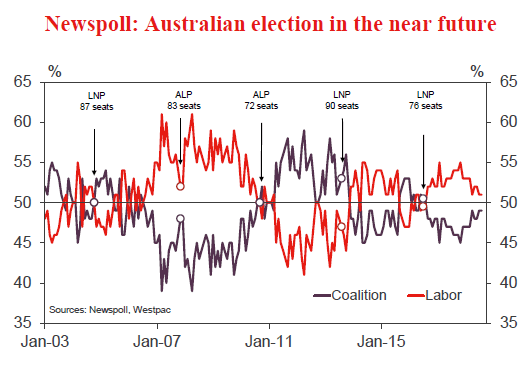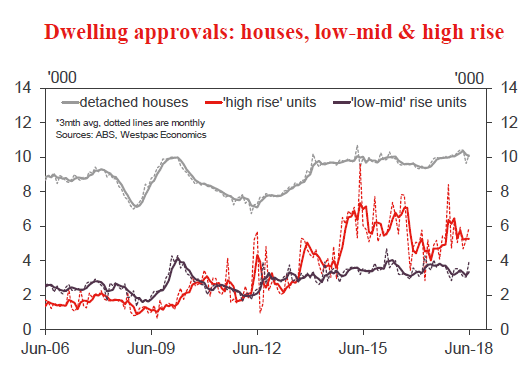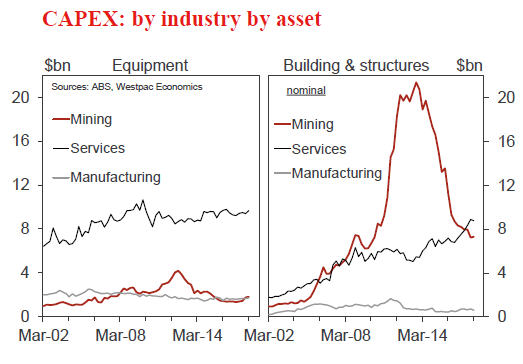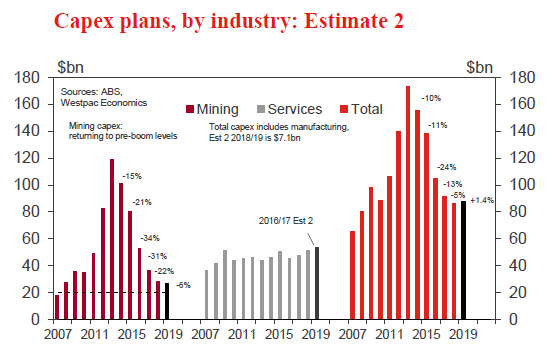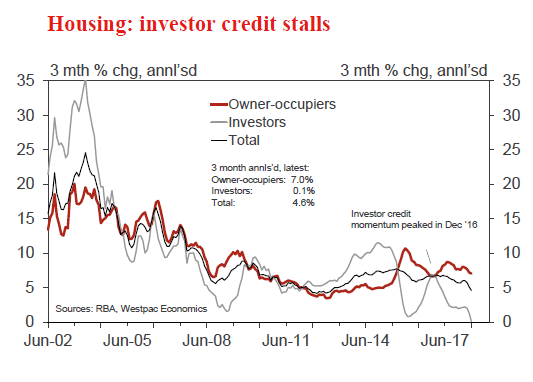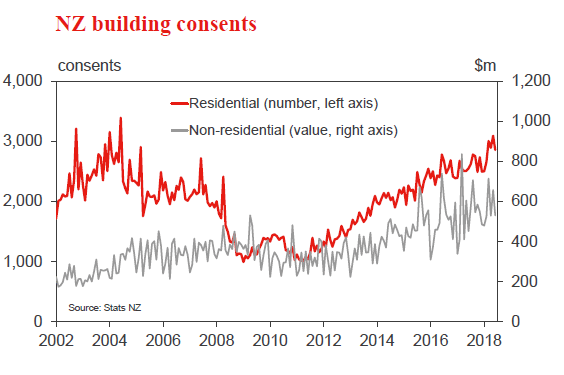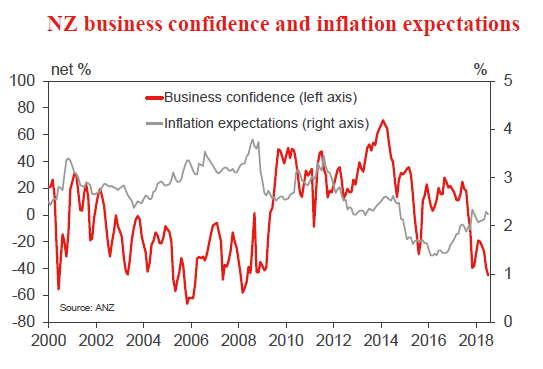Week beginning 27 August 2018
- Westpac extends forecast to 2020 – RBA cash rate to remain on hold in 2020.
- Australia: dwelling approvals, capex, credit.
- NZ: residential building consents, business confidence.
- China: official NBS PMI’s.
- Europe: CPI, employment, ECB Chief Economist Praet speaks.
- US: PCE inflation.
- Key economic & financial forecasts.
Information contained in this report current as at 24 August 2018.
Westpac extends forecasts to end 2020 – RBA cash rate to remain on hold in 2020
To date Westpac has issued public forecasts for the outlook for growth and financial markets to March 2020.
These forecasts are incorporated in the August Market Outlook publication.
We are now extending those forecasts to end 2020.
Last year around this time we surprised markets by forecasting no change in the RBA cash rate out to end 2019. At the time markets were priced for at least three rate hikes (25 basis points per move) and the overwhelming majority of forecasters were anticipating the rate hike cycle to begin in 2018.
Markets have now partly moved into line with our view with only around a 50% probability of one rate hike by the end of 2019. Furthermore, 65% of forecasters in the Bloomberg survey are still expecting the cycle to begin by the third quarter of 2019.
Our view is that the cash rate is likely to remain on hold not only through 2018 and 2019 but also 2020.
Some may argue that we are unrealistically forecasting that Australia will completely miss the global rate hike cycle if rates remain on hold for such an extended period.
We differ from that view arguing that financial conditions are affected by more forces than just the RBA cash rate.
Through 2017 and 2018 we are already observing tightening conditions in the absence of RBA rate hikes.
This tightening is emanating from heightened macroprudential policies from the banking regulator APRA and the rise in wholesale funding costs for banks and corporates.
New lending to housing investors has fallen by 25% over the last year; housing credit growth is likely to slow from 6.5% in the year to September 2017 to 4% in 2018/19 and 2019/20. The bank bill rate has “settled” at around 25 basis points above those levels, which prevailed in previous years and is priced in markets to remain there for at least the next year or so.
As a direct reflection of that tightening in financial conditions we are now seeing housing markets weakening with outright price falls in both Sydney and Melbourne.
These price corrections look set to be sustained for at least the remainder of 2018 and 2019 with soggy markets likely prevailing through 2020.
Housing markets typically recover when there is an increase in new buyers in the market. That increase can be attributed to a boost in affordability or a rise in confidence.
In previous cycles affordability has been boosted by multiple rate cuts from the Reserve Bank; lower prices; and rising incomes.
In this cycle the Reserve Bank has made it clear that short of a major global financial shock (most likely emanating from China) or a major collapse in the local housing market, it will resist cutting the cash rate.
Neither of those scenarios figure in our central case.
Furthermore, we do not envisage a marked lift in income growth over the forecast period. Accordingly the “responsibility” for the restoration of affordability in the two major housing markets will accrue to prices. So an extended period of price weakness is required before we return to levels of affordability that will attract new buyers and stabilise the markets.
Confidence will also be a factor that will discourage new entrants over the 2019 period as the economy deals with uncertainty around the electoral process. In that regard the parties have significant differences regarding tax policies for property investors.
The global environment through 2019 and 2020 will not signal any need to further tighten financial conditions. We expect that the US economy will be slowing through the second half of 2019 and through 2020. We currently anticipate that the Federal Reserve will go on hold in the second half of 2019.
The risk to this scenario is a sharper increase in inflation in 2018 and 2019 as the US economy deals with the “cocktail” of an unemployment rate well below full employment and a strong fiscal stimulus. This would result in a larger and longer tightening cycle through 2019 to be followed by an even sharper slowdown in 2020.
China has signalled its commitment to reduce leverage. This is likely to be a sustained commitment through 2018; 2019; and 2020 as the authorities grapple with the need to diffuse the distortionary impact of the largely unregulated shadow banking system.
As we have seen in recent weeks the authorities will have no patience for a sudden slowdown in growth (likely precipitated by the reduced leverage and the concerns around trade wars). However the authorities are still expected to accept a gradual slowing to a growth pace somewhat below current market expectations, (Westpac expects China’s growth rate in 2019 and 2020 to slow to 6.0%).
With the US and China in a slowdown phase it is unlikely that Europe or the emerging markets will be in a position to fill the “growth hole” that would develop in 2019 and 2020.
For Australia, we continue to expect that inflation will struggle to sustain the bottom of the Bank’s 2–3% target zone. Low inflationary expectations; ongoing slack in the labour market; very limited upward pressure on wages; and falling energy prices will all keep the inflation rate anchored around 2%. (Recall that headline inflation has consistently undershot 2% for virtually all of the period since September 2014 and the Bank is predicting 1.75% for 2018).
In fact the Bank’s own forecasts are not consistent with the pre conditions for a tightening until well into 2020. “It is likely to be some time before we are at full employment and the inflation rate is comfortably within the target range on a sustained basis”. (Governor Lowe, Opening Statement to the House of Representatives Standing Committee on Economics, August 17).
Full employment is defined at 5% and the Bank does not expect to be there until the second half of 2020 while inflation is not forecast to be above 2% until 2020. As has been noted by Bank officials it is uncertain whether 5% is, indeed, Australia’s full employment rate. Evidence from the US and some other countries points to the full employment rate being lower than in previous cycles largely due to structural change around technology and globalisation.
We are also sceptical about Australia’s growth outlook.
The Reserve Bank is forecasting GDP growth of 3.25% (2018); 3.25% (2019) and 3% (2020). That compares with our forecasts of 2.7%; 2.5%; and 2.8%.
The key dynamic here is an expectation that the household can continue growing its consumption spending at around a 3% pace (note that the Bank consistently refers to the outlook for consumption being a source of uncertainty).
That will require a solid lift in wages growth (Government Budget forecasts of 3.25% in 2019/20 and 3.5% in 2020/2021) to support incomes; a negligible negative wealth effect from the falls in house prices and a sustained growth in employment averaging above 1.8% over the next few years.
We are more cautious about the outlook for wages growth expecting low inflationary expectations and considerable ongoing slack in the labour market to contain wage pressures. We also expect the current slowdown in employment growth to be sustained through 2019 particularly as the uncertainty around political developments weigh on business confidence, spending and employment plans.
In turn a cautious consumer is also likely to temper investment plans in plant and equipment.
While government spending will remain robust its contribution to growth will ease. Exports are also likely to support growth although the height of the boost from the LNG will be 2019 as production levels are expected to peak in that year. To an extent the slowdown in resource export growth will be compensated by the boost to services exports from the lower Australian dollar.
Conclusion
The Australian economy is currently being subject to tightening financial conditions despite the RBA cash rate remaining on hold. The impact of these tightening conditions is likely to last through 2018; 2019; and 2020. The Reserve Bank is unlikely to ease rates to offset these forces given the “high bar” it has set for cutting rates.
APRA and the Reserve Bank have used other policies to address Australia’s household debt burden. These policies seem likely to be sustained for a number of years. No further conventional tightening of policy through a rate hike from the Reserve Bank seems likely – even as far out as 2020.
The Bank sets the unemployment rate and inflation as the keys to triggering higher rates. Our unemployment and inflation forecasts are consistent with steady rates in 2020.
Other issues supporting our view that rates will remain on hold through 2020 are a slowing in the global economy, particularly from the second half of 2019; a long adjustment process for house prices; low inflationary expectations; weak wages growth and a negative wealth effect.
We confirm our expectation that the Australian dollar will reach USD 0.70 in 2019 but, in response to a slowing US economy; the Federal Reserve going on hold and Australia’s growth rate bottoming out in 2019 we expect that the AUD can recover slowly to around USD 0.75 through 2020 partly reflecting that weaker US dollar.
The week that was
The past week has been a quiet one for economic data, with political tension and monetary policy here and abroad instead the focus.
Beginning with the RBA, the minutes from their August Board meeting carried a very familiar tone, showing optimism over the global outlook (albeit while noting caution over trade policy and China’s financial system) and confidence in the underlying strength of our own economy. Notably, the RBA highlighted that they believe the “recent increase in minimum wages, the announcement of future tax cuts, and expectations of a further tightening in labour market conditions had reduced some of the uncertainty around the outlook for consumption.” The outlook for business investment was also viewed favourably, although non-mining investment growth was expected to be a little softer than the past year. The discussion of housing market developments was limited to the facts, with no outlook or overt concern offered. All things considered, the RBA remains of the view that the next move in rates is more likely to be up than down, albeit not in the near term.
On that front, this week Westpac Economics extended our longheld on-hold call for the RBA’s cash rate to the end of 2020. As detailed by Chief Economist Bill Evans:
“Last year around this time we surprised markets by forecasting no change in the RBA cash rate out to end 2019. At the time markets were priced for at least three rate hikes (25 basis points per move) and the overwhelming majority of forecasters were anticipating the rate hike cycle to begin in 2018. Markets have now partly moved into line with our view with only around a 50% probability of one rate hike by the end of 2019. ”
While the RBA’s cash rate has been on hold, financial conditions have clearly tightened in Australia as a result of APRA’s macroprudential policies and the rise in wholesale funding costs for banks and corporates. Australia’s housing markets have weakened as a result, a correction that we believe is likely to continue for at least the remainder of 2018 and 2019. Housing is then set to remain soggy through 2020 in the absence of support from a rate cut or a marked lift in income growth – as has been seen in the past.
More broadly for Australia, we look for labour market slack and subdued wages growth to persist. Under such a scenario, the optimistic expectations of the RBA and Government around the consumer are unlikely to come to pass, also limiting the upside for business investment. We believe this combination is expected to keep GDP growth at or below trend through the end of 2020, and inflation near the lower bound of the RBA’s 2–3% target range.
To this domestic view, the global economy creates a number of risks, largely to the downside. Of particular note is the domestic slowdown in China, led by systematic reform of their financial sector and government directives on investment, further exaggerated by trade tensions with the US. Note that the latter escalated further this week, as the US and China made no progress during two days of talks, and the next wave of tariffs on $16bn of imports from each nation came into effect.
Of the releases made available, Australian construction work done was most worthy of note. The headline print was above expectations at 1.6% as new housing construction formed a double peak (the first having been seen in 2016) and public sector infrastructure spending showed continued strength. Whereas residential investment will slow through 2019, growth in public sector spending will endure. The reason being, Australia is still in catch up mode on infrastructure investment, with a clear need to build out transport and essential infrastructure to meet the needs of a rapidly growing population. This is particularly the case in Sydney and Melbourne. For June quarter GDP though, the strength shown in residential construction will be offset by a pullback in renovation work, as the latter has a higher weight in the calculation of GDP than in this release.
Finally coming back to monetary policy, the minutes of the July/ August FOMC meeting were also released in the US. There were two key take outs. The first is that rate hikes will continue in the near term, supported by a strong labour market, fiscal stimulus and underlying momentum. We see a window for four more hikes from September 2018 to June 2019.
Thereafter, a material change in the FOMC’s stance is likely to be seen as growth slows back to trend from late-2019. From that point until the end of our 2020 forecast horizon, we believe the fed funds rate will remain unchanged and market pricing will adjust to view June 2019 as the peak in the fed funds rate for this cycle. Into the weekend, the Kansas City Federal Reserve’s Jackson Hole economic conference will continue. Chair Powell’s address on ‘Monetary policy in a changing economy’ will likely provide further guidance on the outlook.
Chart of the week: Australia leadership spill
After the motion to spill the Liberal Party leadership was carried, the former Prime Minister Malcolm Turnbull has reportedly indicated that he will leave Parliament not before too long.
The consequent follow-up leadership vote saw a victory for the new Prime Minister Scott Morrison and his deputy Josh Frydenberg.
The Government has until May 2019 to call the Federal Election with the most recent polling suggesting that they trail the opposition Labor Party.
New Zealand: week ahead & data wrap
Falling into place
We recently released our latest Economic Overview1. It highlights that the economic slowdown that we have long warned of is well in train, with earlier drivers of growth having now moved into new phases. The coming year will see a temporary pickup in growth, supported by firmness in export earnings and large increases in fiscal spending. Nevertheless, economic growth over the next few years will be noticeably slower than it was between 2014 and 2016.
After fairly modest growth of 0.5 to 0.6% in recent quarters (rates that were effectively the same as population growth), we expect that GDP growth rebounded to around 1% in June. That’s in part due to some temporary factors, particularly in the agricultural sector. Retail sales data this week have added credence to the idea of a near-term bounce in GDP, with a stronger than expected 1.1% increase in spending in June, underpinned by a lift in core categories.
This rebound in GDP growth is likely to come as a surprise to the Reserve Bank, whose latest policy assessment only factored in an increase of 0.5% in the June quarter. That’s particularly important for financial markets. Since the RBNZ’s August Statement, markets have been pricing in some chance of a near-term rate cut and the NZ dollar has taken a step down. But with it now looking increasingly likely that growth will surprise the RBNZ to the upside, we could see some correction when June quarter GDP is released in late September.
But while GDP growth looks to have rebounded recently, stepping back and looking at the economy more broadly leaves us with a picture of cooling activity. On an annual basis, we estimate that GDP growth has slowed to 2.7% in the year to June. That’s a noticeable step down from the rates of 3.5 to 4% annual growth that we saw in earlier years.
This cooling in economic growth has been playing out very much as we have expected. As we’ve been highlighting for some time, several of the key factors that underpinned demand in recent years have been evolving, and are no longer providing the same boosts to growth that they once did. We’ve seen this on several key fronts.
First is reconstruction spending in Canterbury, which has slowed sharply since it peaked over 2015 and 2016. The continuing wind down in reconstruction work will be a drag on growth for several more years, the impact of which will be felt across the economy.
Construction activity more generally remains elevated, but the sector is unlikely to be the driver of growth and employment that it was in earlier years. That’s because factors such as stretched capacity, rising costs, and difficulties accessing finance are providing a brake on how quickly building activity can ramp up.
Tax changes have seen house price inflation slowing sharply, with particular softness in Auckland. Restrictions on foreign buyers that are about to come into effect will reinforce this weakness. However, we expect that a drop in mortgage rates and a likely easing in the Reserve Bank’s loan-to-value restrictions in January will provide some counterbalance. Nevertheless, we are still looking at a subdued outlook for house prices, with modest house price declines over the next few years. And with New Zealand households holding a large proportion of their wealth in owneroccupied and investment housing, this will be a significant drag on spending.
Finally, net migration remains elevated, but has been declining. Figures out over the past week showed that the net inflow of people into the country has slowed to just under 64,000 in the year to July – its lowest level since 2015. We expect that net migration will slow substantially further over the coming years. That will see population growth slowing from around 2% currently to around 1% in 2022, signalling a huge reduction in what has been an ‘easy’ source of demand growth for many businesses.
Against this cooling in GDP growth and changes in the policy back drop, we have seen a sharp decline in business confidence. However, business surveys appear to be overstating the degree of weakness in activity. In fact, we expect that the next phase of the economic cycle will be a pickup in GDP growth to just over 3% in 2019.
Underpinning the expected lift in near-term growth are large increases in Government spending that are now being rolled out. That includes around $1.5b of spending on the Government’s families package and accommodation support payments, as well as increased spending in areas like health and education.
Strength in the export sector will also help to bolster New Zealand’s economic performance. While there has been a softening in the prices for some commodities recently (most notably dairy prices, which were down another 3.6% in the latest auction), the terms of trade remain elevated. We’re also seeing continued firmness in services exports. Going forward, export returns will be boosted by the depreciation of the New Zealand dollar, which we expect to continue over the coming year.
However, the above factors are only providing a temporary fillip. Beyond 2019, we expect GDP growth to cool once again, as slowing population growth and weakness in the housing market offset increases in fiscal spending. Overall, growth over the next few years will be noticeably slower than it was between 2014 and 2016.
Data Previews
Aus Jul dwelling approvals
- Aug 30, Last: 6.4%, WBC f/c: –3.0%
- Mkt f/c: -2.0%, Range: -5.0% to 2.0%
Dwelling approvals bounced 6.4% in June, coming in well above expectations. The detail confirmed May’s 2.5% decline was likely a data issue with Qld approvals rebounding from their extreme fall. Outside of this, the picture is more mixed but is clearly not showing the anticipated weakening, particularly across high rise which recorded another relatively strong month.
Approvals are likely to retrace 3% in July with some risk of a sharper fall. Construction-related finance approvals have been pointing to a pull-back in non high rise approvals for several months now, a shift that has not yet materialised. Similarly, site purchases have been pointing to a further sharp leg lower for high rise approvals for some time now. With the Sydney and Melbourne housing markets swinging into price corrections and financing conditions tightening for both home buyers and developers, we may also start to see projects proceed more slowly or be shelved altogether
Aus Q2 business capex
- Aug 30, Last: 0.4%, WBC f/c: 0.3%
- Mkt f/c: 0.6%, Range: -1.0% to 3.0%
Business capex spending turned the corner in 2017, with the mining investment wind-down almost complete and an emergence upswing in non-mining investment. Capex rose 4% in 2017 after four years of decline.
In 2018, capex edged 0.4% higher in Q1 and we anticipate a rise of 0.4% in Q2.
Building & structures capex is expected to slip, declining by 0.3%. The Construction Work survey reported that infrastructure activity fell (as gas projects are completed), largely offset by a rise in non-residential building work.
Equipment spending has trended higher since mid-2017, emerging from a soft spot over the second half of 2016. We anticipate a further gain in Q2, a forecast +1%. Profits are up, so too capacity utilisation levels, global growth has been strong and there are positive spill-over effects from the strong upswing in public infrastructure.
Aus 2018/19 capex plans
- Aug 30, Last (Est 2 for 2018/19): $87.7bn, +1.4%
This survey, conducted during July and August, includes the 3rd estimate of capex spending plans for 2018/19.
In the previous survey, Est 2 for 2018/19 was $87.7bn, 1% above Est 2 a year ago. This is the first positive ‘Est 2 on Est 2’ comparison since 2012/13.
For mining, Est 2 on Est 2 is only a modest negative, at -5.8%. For services, Est 2 vs Est 2 is +4.8%, evidence that the investment upswing is set to continue.
This update is likely to confirm the broad themes evident in the capex survey 3 months earlier. However, as to the value of Est 3, we see the risk of some apparent slippage.
For Est 3 on Est 3 to be at +1% (matching the Est 2 on Est 2 outcome) would require an upgrade to $104bn. That is a hefty 19% above Est 2 – yes the same upgrade as this time last year, but that was an abnormally sharp increase (the largest since 1988/89). A figure around $102bn, -1% vs Est 3 a year ago, may be more achievable.
Aus Jul private credit
- Aug 31, Last: 0.3%, WBC f/c: 0.3%
- Mkt f/c: 0.3%, Range: 0.2% to 0.5%
Private sector credit growth is modest and slowing as housing cools. Monthly growth averaged 0.3% in Q2, and annual growth eased to 4.5%, down from 5.5% a year ago. For July, we anticipate an increase of 0.3%.
Housing credit, at this late stage of the cycle, is slowing as tighter lending conditions see new lending decline, particularly for investors. In June, total housing credit growth was 0.34%mth, 5.6%yr, while the figures for investors were -0.1%mth, 1.6%yr.
Business credit, 3.2% above the level of a year ago, is volatile around a modest uptrend as businesses increase investment in the real economy, spending which is in part funded by retained earnings. The June month was an ‘average’ one, with a gain of 0.3% – we anticipate a similar result for July.
Personal credit continues to contract, -1.3% over the year.
NZ Jul residential building consents
- Aug 30, Last: -7.6%, WBC f/c: -5%
Residential dwelling consent issuance fell by 7.6% in June. However, that followed solid levels of dwelling consent issuance in the preceding months, and still left consent numbers at a high level.
Recent volatility in consents has been related to apartments and retirement villages, which tend to get issued in lumps. We expect that swings in this group will again contribute to a modest 5% fall in July (that follows a large increase in June centred on Wellington).
The more interesting story is what’s happening to consents for stand-alone and medium density housing in Auckland. Issuance in these groups has taken a large step higher in recent months, supported by regulatory changes and strong population growth. Smoothing through month-to-month swings, we expect issuance in these categories to remain firm.
NZ Aug ANZ business confidence
- Aug 30, Last: -44.9
Business confidence has lurched lower again in recent months, with the July survey falling to levels last seen during the Global Financial Crisis.
There is no doubt a political element to this survey, with firms displeased in particular with the new Government’s intended changes to employment law. However, confidence has been falling since well before the election, and there does appear to have been some genuine slowing in growth in the last year.
Inflation expectations have been higher since the election, with rising fuel prices likely playing a role as well. However, firms still don’t seem all that confident about their ability to pass on cost increases; pricing intentions have remained within a range over the last year or so.




